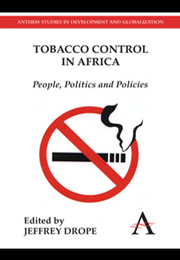Book contents
- Frontmatter
- Contents
- List of Figures and Tables
- Foreword
- Preface
- Acknowledgments
- List of Abbreviations and Acronyms
- 1 Introduction
- 2 The Political Mapping Process
- 3 Progress on Smoke-Free Policies
- 4 Taxation as a Tobacco Control Strategy
- 5 The Challenges of Implementing Bans on Advertising, Promotion and Sponsorship
- 6 The Pursuit of Packaging and Labeling Requirements
- 7 Burkina Faso
- 8 Cameroon
- 9 Eritrea
- 10 Ghana
- 11 Kenya
- 12 Malawi
- 13 Mauritius
- 14 Nigeria
- 15 Senegal
- 16 South Africa
- 17 Tanzania
- 18 Zambia
- 19 Conclusion: Tobacco Control in Africa – People, Politics and Policies
- Notes on Contributors
- Index
16 - South Africa
Published online by Cambridge University Press: 05 March 2012
- Frontmatter
- Contents
- List of Figures and Tables
- Foreword
- Preface
- Acknowledgments
- List of Abbreviations and Acronyms
- 1 Introduction
- 2 The Political Mapping Process
- 3 Progress on Smoke-Free Policies
- 4 Taxation as a Tobacco Control Strategy
- 5 The Challenges of Implementing Bans on Advertising, Promotion and Sponsorship
- 6 The Pursuit of Packaging and Labeling Requirements
- 7 Burkina Faso
- 8 Cameroon
- 9 Eritrea
- 10 Ghana
- 11 Kenya
- 12 Malawi
- 13 Mauritius
- 14 Nigeria
- 15 Senegal
- 16 South Africa
- 17 Tanzania
- 18 Zambia
- 19 Conclusion: Tobacco Control in Africa – People, Politics and Policies
- Notes on Contributors
- Index
Summary
Executive Summary
The country's tobacco control success stands in sharp contrast to many other middle- and low-income countries where the tobacco epidemic is still growing. Large reductions in tobacco use have occurred in South Africa because of a combination of government commitment to comprehensive legislation and enforcement (four major pieces of legislation since 1992) and effective civil society–driven public health activism and community support. Moreover, research played an essential role by supporting both policy development and advocacy efforts. However, prevalence rates remain high (approximately 23 percent of adults are daily smokers; and noncigarette tobacco use, particularly in lower socioeconomic groups, is a continuing concern), the tobacco industry is powerful and the tobacco control community reports having to counter both public and government sentiment that tobacco control has “been done.” By the tobacco control community's own admission, for every victory, the industry has tried to claw back part of the gain – they believe not only that there is more work to be done, but that it will require continued vigorous effort.
Most recently, the tobacco control community won a signifi cant victory in ensuring that the 2010 FIFA World Cup would have smoke-free spectator venues. Currently, tobacco control advocates are examining the effi cacy of existing tobacco taxation policies. While South Africa previously had excellent tobaccooriented tax policies that directly decreased the affordability of cigarettes, recent falls in infl ation and economic growth have made these policies less effective.
- Type
- Chapter
- Information
- Tobacco Control in AfricaPeople, Politics and Policies, pp. 227 - 246Publisher: Anthem PressPrint publication year: 2011
- 2
- Cited by



